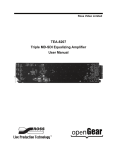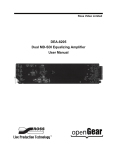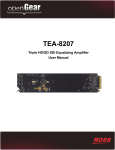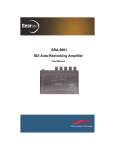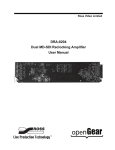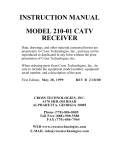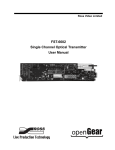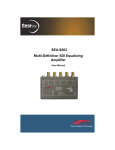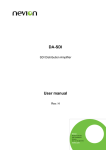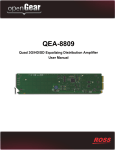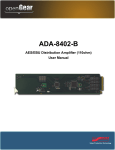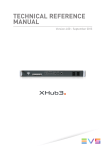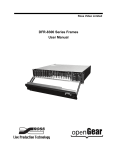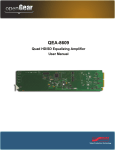Download TRA-8206 User Manual
Transcript
Ross Video Limited TRA-8206 Triple MD-SDI Reclocking Amplifier User Manual TRA-8206 • Triple MD-SDI Reclocking Amplifier User Manual • Ross Part Number: 8206DR-004-05 • Release Date: March 17, 2010. Printed in Canada. The information contained in this manual is subject to change without notice or obligation. Copyright © 2010 Ross Video Limited. All rights reserved. Contents of this publication may not be reproduced in any form without the written permission of Ross Video Limited. Reproduction or reverse engineering of copyrighted software is prohibited. Patents This product is protected by the following US Patents: 4,205,346; 5,115,314; 5,280,346; 5,561,404; 7,034,886; 7,508,455. This product is protected by the following Canadian Patents: 2039277; 1237518; 1127289. Other patents pending. Notice The material in this manual is furnished for informational use only. It is subject to change without notice and should not be construed as commitment by Ross Video Limited. Ross Video Limited assumes no responsibility or liability for errors or inaccuracies that may appear in this manual. Trademarks • • is a registered trademark of Ross Video Limited. is a trademark of Ross Video Limited. • Ross, ROSS, ROSS® are registered trademarks of Ross Video Limited. • DashBoard Control System™ is a trademark of Ross Video Limited. • All other product names and any registered and unregistered trademarks mentioned in this guide are used for identification purposes only and remain the exclusive property of their respective owners. Important Regulatory and Safety Notices Before using this product and any associated equipment, refer to the “Important Safety Instructions” listed below to avoid personnel injury and to prevent product damage. Products may require specific equipment, and/or installation procedures to be carried out to satisfy certain regulatory compliance requirements. Notices have been included in this publication to call attention to these specific requirements. Symbol Meanings This symbol on the equipment refers you to important operating and maintenance (servicing) instructions within the Product Manual Documentation. Failure to heed this information may present a major risk of damage or injury to persons or equipment. Warning — The symbol with the word “Warning” within the equipment manual indicates a potentially hazardous situation which, if not avoided, could result in death or serious injury. Caution — The symbol with the word “Caution” within the equipment manual indicates a potentially hazardous situation which, if not avoided, may result in minor or moderate injury. It may also be used to alert against unsafe practices. Notice — The symbol with the word “Notice” within the equipment manual indicates a situation, which if not avoided, may result in major or minor equipment damage or a situation which could place the equipment in a non-compliant operating state. ESD Susceptibility — This symbol is used to alert the user that an electrical or electronic device or assembly is susceptible to damage from an ESD event. Important Safety Instructions Caution — his product is intended to be a component product of the DFR-8300 series frame. Refer to the DFR-8300 series frame User Manual for important safety instructions regarding the proper installation and safe operation of the frame as well as its component products. Warning — Certain parts of this equipment namely the power supply area still present a safety hazard, with the power switch in the OFF position. To avoid electrical shock, disconnect all A/C power cards from the chassis’ rear appliance connectors before servicing this area. Warning — Service barriers within this product are intended to protect the operator and service personnel from hazardous voltages. For continued safety, replace all barriers after any servicing. This product contains safety critical parts, which if incorrectly replaced may present a risk of fire or electrical shock. Components contained with the product’s power supplies and power supply area, are not intended to be customer serviced and should be returned to the factory for repair. To reduce the risk of fire, replacement fuses must be the same time and rating. Only use attachments/accessories specified by the manufacturer. EMC Notices United States of America FCC Part 15 This equipment has been tested and found to comply with the limits for a class A Digital device, pursuant to part 15 of the FCC Rules. These limits are designed to provide reasonable protection against harmful interference when the equipment is operated in a commercial environment. This equipment generates, uses, and can radiate radio frequency energy and, if not installed and used in accordance with the instruction manual, may cause harmful interference to radio communications. Operation of this equipment in a residential area is likely to cause harmful interference in which case the user will be required to correct the interference at his own expense. Notice — Changes or modifications to this equipment not expressly approved by Ross Video Limited could void the user’s authority to operate this equipment. CANADA This Class “A” digital apparatus complies with Canadian ICES-003. Cet appariel numerique de la classe “A” est conforme a la norme NMB-003 du Canada. EUROPE This equipment is in compliance with the essential requirements and other relevant provisions of CE Directive 93/68/EEC. INTERNATIONAL This equipment has been tested to CISPR 22:1997 along with amendments A1:2000 and A2:2002, and found to comply with the limits for a Class A Digital device. Notice — This is a Class A product. In domestic environments, this product may cause radio interference, in which case the user may have to take adequate measures. Maintenance/User Serviceable Parts Routine maintenance to this openGear product is not required. This product contains no user serviceable parts. If the module does not appear to be working properly, please contact Technical Support using the numbers listed under the “Contact Us” section on the last page of this manual. All openGear products are covered by a generous 5-year warranty and will be repaired without charge for materials or labor within this period. See the “Warranty and Repair Policy” section in this manual for details. Environmental Information The equipment that you purchased required the extraction and use of natural resources for its production. It may contain hazardous substances that could impact health and the environment. To avoid the potential release of those substances into the environment and to diminish the need for the extraction of natural resources, Ross Video encourages you to use the appropriate take-back systems. These systems will reuse or recycle most of the materials from your end-of-life equipment in an environmentally friendly and health conscious manner. The crossed-out wheeled bin symbol invites you to use these systems. If you need more information on the collection, reuse, and recycling systems, please contact your local or regional waste administration. You can also contact Ross Video for more information on the environmental performances of our products. Company Address Ross Video Limited Ross Video Incorporated 8 John Street Iroquois, Ontario Canada, K0E 1K0 P.O. Box 880 Ogdensburg, New York USA 13669-0880 General Business Office: (+1) 613 • 652 • 4886 Fax: (+1) 613 • 652 • 4425 Technical Support: (+1) 613 • 652 • 4886 After Hours Emergency: (+1) 613 • 349 • 0006 E-mail (Technical Support): [email protected] E-mail (General Information): [email protected] Website: http://www.rossvideo.com Contents Introduction 1 Overview.............................................................................................................................. 1-2 Features.................................................................................................................. 1-2 Functional Block Diagram................................................................................................... 1-3 Documentation Terms and Conventions.............................................................................. 1-4 Installation 2 Before You Begin ................................................................................................................ 2-2 Static Discharge..................................................................................................... 2-2 Unpacking.............................................................................................................. 2-2 Installing the TRA-8206 ...................................................................................................... 2-3 Rear Modules for the TRA-8206........................................................................... 2-3 Installing a Rear Module ....................................................................................... 2-3 Board Installation .................................................................................................. 2-4 Cabling for the TRA-8206 ................................................................................................... 2-5 Connections for the DFR-8310 Series Frames...................................................... 2-5 Connections for the DFR-8321 Series Frames...................................................... 2-5 User Controls 3 Card Overview ..................................................................................................................... 3-2 Output Channel Configuration............................................................................................. 3-4 Channel Rate Selection Buttons and LEDs ........................................................... 3-4 Single, Dual, or Triple Channel Jumper Configurations ...................................... 3-5 Control and Monitoring ....................................................................................................... 3-6 Status and Selection LEDs on the TRA-8206 ....................................................... 3-6 Factory Default Values.......................................................................................... 3-7 Reclocker Rate Selection ..................................................................................................... 3-8 Reclocker Rate Selection LEDs ............................................................................ 3-8 Menus 4 SNMP Monitoring and Control ........................................................................................... 4-2 Dashboard Control System Software................................................................................... 4-3 Status Tabs ............................................................................................................ 4-3 Setup Menus .......................................................................................................... 4-4 Routing Menus ...................................................................................................... 4-4 Alarms Menus ....................................................................................................... 4-5 Specifications 5 Technical Specifications ...................................................................................................... 5-2 Service Information 6 Troubleshooting Checklist ................................................................................................... 6-2 Bootload Button .................................................................................................... 6-2 Warranty and Repair Policy................................................................................................. 6-3 TRA-8206 User Manual (Iss. 05) Contents • i ii • Contents TRA-8206 User Manual (Iss. 05) Introduction In This Chapter This chapter contains the following sections: • Overview • Functional Block Diagram • Documentation Terms and Conventions A Word of Thanks Congratulations on choosing an openGear TRA-8206 Triple MD-SDI Reclocking Amplifier. Your TRA-8206 is part of a full line of Digital Products within the openGear Terminal Equipment family of products, backed by Ross Video's experience in engineering and design expertise since 1974. You will be pleased at how easily your new TRA-8206 fits into your overall working environment. Equally pleasing is the product quality, reliability and functionality. Thank you for joining the group of worldwide satisfied Ross Video customers! Should you have a question pertaining to the installation or operation of your TRA-8206, please contact us at the numbers listed on the back cover of this manual. Our technical support staff is always available for consultation, training, or service. TRA-8206 User Manual (Iss. 05) Introduction • 1–1 Overview The TRA-8206 is a three channel Multi-Definition SDI distribution amplifier, capable of equalizing and reclocking all common serial digital signals. Support for both standard-definition and high-definition signals makes the TRA-8206 a universal SDI distribution amplifier. Each channel of the TRA-8206 equalizes the incoming SDI signal, compensating for up to 300m of cable at 270Mbps and over 120m of cable at 1.485Gbps. The signal is then reclocked, with automatic rate detection for all popular data rates. Each channel is fully independent and can run at different data rates. LED indicators at the front of the card identify the presence of incoming video and the identified signal data rate for each channel independently. A special feature of the TRA-8206 is the ability to operate in a number of different channel configurations. The triple channel mode is ideal for applications requiring only 1 or 2 outputs, such as mid-cable signal boosters, router expansion, or signal cleanup. Up to 30 SDI distribution channels can be housed in a 2RU space. Special attention has been taken to ensure the SDI outputs faithfully reproduce the incoming signals, with excellent jitter and return loss specifications. LED indicators at the front of the card identify the presence of incoming video, simplifying system troubleshooting. Features The following features make the TRA-8206 the best solution for general SDI equalizing, reclocking, and distribution: 1–2 • Introduction • Three independent channels of SDI distribution • Flexible channel configurations: › Single channel 1:7 amplifier › Dual channel 1:4 + 1:3 amplifier › Dual channel 1:5 + 1:2 amplifier › Triple channel 1:3 + 1:2 + 1:2 amplifier • Equalizes and reclocks all popular SDI signals from 143Mbps to 1.485Gbps • Equalizes up to 300m of Belden 1694A cable at 270Mbps, or over 120m of cable at 1.485Gbps • Automatic detection of incoming data rate • LED indicators for signal presence and data rate for each channel • Excellent input and output return loss exceeds SMPTE specifications • Fits openGear DFR-8300 series frames • 5 year transferable warranty TRA-8206 User Manual (Iss. 05) Functional Block Diagram This section provides a functional block diagram that outlines the workflow of the TRA-8206. SDI OUT Channel A BNC 1 Equalizer Channel C BNC 10 Equalizer Reclocker Channel B BNC 9 Equalizer Reclocker BNC 2 Reclocker BNC 4 BNC 3 Crosspoint BNC 5 BNC 6 BNC 7 BNC 8 Figure 1.1 TRA-8206 — Simplified Block Diagram TRA-8206 User Manual (Iss. 05) Introduction • 1–3 Documentation Terms and Conventions The following terms are used throughout this manual: • “Frame” refers to the DFR-8300 series frame that houses the TRA-8206 card. 1–4 • Introduction • All references to the DFR-8300 series frame also include the 10-slot versions (DFR-8310) and the 20-slot frame versions (DFR-8321 series). • “Operator” and “User” both refer to the person who uses the TRA-8206. • “Board” and “Card” both refer to the TRA-8206 card itself, including all components and switches. • “System” and “Video system” both refer to the mix of interconnected production and terminal equipment in which the TRA-8206 operates. • “DashBoard” refer to the DashBoard Control System™. • The “Operating Tip” and “Note” boxes are used throughout this manual to provide additional user information. TRA-8206 User Manual (Iss. 05) Installation In This Chapter This chapter provides instructions for installing the rear module(s) for the TRA-8206, installing the card into the frame, and cabling details. The following topics are discussed: • Before You Begin • Installing the TRA-8206 • Cabling for the TRA-8206 TRA-8206 User Manual (Iss. 05) Installation • 2–1 Before You Begin Before proceeding with the instructions in this chapter, ensure that your DFR-8300 series frame is properly installed according to the instructions in the DFR-8300 Series User Manual. Static Discharge Whenever handling the TRA-8206 and other related equipment, please observe all static discharge precautions as described in the following note: ESD Susceptibility — Static discharge can cause serious damage to sensitive semiconductor devices. Avoid handling circuit boards in high static environments such as carpeted areas and when synthetic fiber clothing is worn. Always exercise proper grounding precautions when working on circuit boards and related equipment. Unpacking Unpack each TRA-8206 you received from the shipping container and ensure that all items are included. If any items are missing or damaged, contact your sales representative or Ross Video directly. 2–2 • Installation TRA-8206 User Manual (Iss. 05) Installing the TRA-8206 The TRA-8206 is compatible with the DFR-8300 series frames. The procedure for installing the rear module in your openGear frame is the same regardless of the frame, module, or card used. Rear Modules for the TRA-8206 The rear module for the TRA-8206 depends on the openGear frame you are installing the card into. • DFR-8310 series frames — When installing the TRA-8206 in a DFR-8310 series frame, the 8310AR-030 Rear Module (R1-8206) is required. The TRA-8206 is also compatible with the DFR-8310-BNC frames. • DFR-8321 series frames — When installing the TRA-8206 in a DFR-8321 series frame, the 8320AR-030 Full Rear Module (R2-8206) is required. Installing a Rear Module If you are installing the TRA-8206 in a DFR-8310-BNC frame, or if the rear module is already present, skip this section. Use the following procedure to install the rear module in a DFR-8300 series frame: 1. Refer to the DFR-8300 Series User Manual to ensure that the frame is properly installed according to instructions. 2. Locate the card frame slot on the rear of the frame. 3. Remove the Blank Plate from the rear of the slot you have chosen for card installation. 4. As shown in Figure 2.1, seat the bottom of the rear module in the seating slot at the base of the frame’s back plane. Figure 2.1 Rear Module Installation in a DFR-8310 Series Frame (TRA-8206 not shown) TRA-8206 User Manual (Iss. 05) Installation • 2–3 5. Align the top hole of the rear module with the screw hole on the top edge of the frame back plane. 6. Using a Phillips screwdriver and the supplied screw, fasten the rear module to the frame back plane. Do not over tighten. 7. Ensure proper frame cooling and ventilation by having all rear frame slots covered with rear modules or blank metal plates. This completes the procedure for installing rear module in a DFR-8300 series frame. Board Installation Use the following procedure to install the TRA-8206 in a DFR-8300 series frame: 1. Refer to the DFR-8300 Series User Manual to ensure that the frame is properly installed according to instructions. Note — Heat and power distribution requirements within a frame may dictate specific slot placement of cards. Cards with many heat-producing components should be arranged to avoid areas of excess heat build-up, particularly in frames using convectional cooling. 2. After selecting the desired frame installation slot, hold the TRA-8206 card by the edges and carefully align the card edges with the slots in the frame. 3. Fully insert the card into the frame until the rear connection plugs are properly seated on the midplane and rear modules. 4. Affix the supplied BNC label to the BNC area on the rear module. This completes the procedure for installing the TRA-8206 in a DFR-8300 series frame. For More Information... • 2–4 • Installation on the assignment of input channels to output BNCs via jumper selection, refer to the section “Output Channel Configuration” on page 3-4. TRA-8206 User Manual (Iss. 05) Cabling for the TRA-8206 This section provides instructions for connecting cables to the installed rear modules on the DFR-8300 series frame backplane. The inputs are internally terminated in 75ohms. It is not necessary to terminate unused outputs. Connections for the DFR-8310 Series Frames In the DFR-8310 series frame, the TRA-8206 occupies one slot and provides seven SDI outputs and three SDI inputs. Connect the input and output cables according to Figure 2.2. SDI In Channel A SDI Out 1 1 2 SDI Out 2 SDI Out 1 3 4 SDI Out 2 SDI Out 3 5 6 SDI Out 3 SDI In Channel B SDI Out 3 7 8 9 10 SDI In Channel C Figure 2.2 Cable Connections for the TRA-8206 Connections for the DFR-8321 Series Frames In the DFR-8321 series frame, the TRA-8206 occupies one slot and provides seven SDI outputs and three SDI inputs. Connect the input and output cables according to Figure 2.2. TRA-8206 User Manual (Iss. 05) Installation • 2–5 2–6 • Installation TRA-8206 User Manual (Iss. 05) User Controls In This Chapter This chapter provides a general overview of the user controls available on the TRA-8206. The following topics are discussed: • Card Overview • Output Channel Configuration • Control and Monitoring • Reclocker Rate Selection TRA-8206 User Manual (Iss. 05) User Controls • 3–1 Card Overview The following figure and discussions describe the jumpers and controls on the TRA-8206. 1 3 2 7 4 8 9 5 6 Figure 3.1 Card-edge Controls 1) Card Control (JP1) 4) Channel B Rate Selection (SW2) 7) BNC 2 and 4 Output Configuration (JP3) 2) Loss of Signal (JP2) 5) Channel C Rate Selection (SW3) 8) BNC 3 and 5 Output Configuration (JP4) 3) Channel A Rate Selection (SW1) 6) Bootload Button (SW4) 9) BNC 6, 7, 8 Output Configuration (JP5) 1. Card Control (JP1) Use JP1 to select whether the Output Mute and Output Channel Configuration jumper settings are respected or ignored by remote control settings. Select one of the following options: • REMOTE — the local jumper settings are ignored and the card is configured remotely. • LOCAL — the local jumper settings are respected and card is controlled locally. The card controls and status can be read remotely but not changed (default setting). Note — This setting applies to control of the jumpers only. Card-edge buttons and switch settings can be configured remotely or locally in either setting. 2. Loss of Signal (JP2) Use JP2 to enable or disable the Loss of Signal option as follows: • MUTE — a channel’s outputs will be muted if the input signal degrades to the point that the input EQ can no longer guarantee error-free performance. When the red ERROR LED is lit, the outputs will be muted. If you have input channels set to any rate other than Auto mode, we recommend this jumper position. The output of the card would then mute if an incorrect data rate is applied to the input, or if the input signal became too weak for the input equalizer to compensate. • NO MUTE — a channel’s outputs will work to the limits of the input stage (default setting). 3. Channel A Rate Selection (SW1) Channel A has a rate selection button and corresponding SD and HD LEDs. Use the rate selection button and LEDs to set the input signal rate type that Channel A will process. Pressing the button cycles between the HD and SD options. You can choose between the following signal rate types: • HD — Select this option when using 1.485Gbps rate. • SD — Select this option when using 143, 177, 270, 360, and 540Mbps rates. 4. Channel B Rate Selection (SW2) Channel B has a rate selection button and corresponding SD and HD LEDs. Use the rate selection button and LEDs to set the input signal rate type that Channel B will process. Pressing the button cycles between the HD and SD options. You can choose between the following signal rate types: 3–2 • User Controls TRA-8206 User Manual (Iss. 05) • HD — Select this option when using 1.485Gbps rate. • SD — Select this option when using 143, 177, 270, 360, and 540Mbps rates. 5. Channel C Rate Selection (SW3) Channel C has a rate selection button and corresponding SD and HD LEDs. Use the rate selection button and LEDs to set the input signal rate type that Channel C will process. Pressing the button cycles between the HD and SD options. You can choose between the following signal rate types: • HD — Select this option when using 1.485Gbps rate. • SD — Select this option when using 143, 177, 270, 360, and 540Mbps rates. 6. Bootload Button (SW4) This button is used for factory service in the unlikely event of a complete card failure. The Bootload process is further described in the “Bootload Button” on page 6-2. 7. BNC 2 and 4 Output Configuration (JP3) Use JP3 to select one of the following input channels to output on BNC 2 and BNC 4: • A — BNC 2 and BNC 4 will output the signal input on Channel A. • B — BNC 2 and BNC 4 will output the signal input on Channel B (default setting). • C — Position C is not used on the TRA-8206 and should not be selected. • Blank — The top blank position for these jumpers is for factory use, and should not be selected for normal operation. If selected, the BNCs output the signal input on Channel A. • None — If the jumper is removed, the BNCs will output the signal input on Channel A. 8. BNC 3 and 5 Output Configuration (JP4) Use JP4 to select one of the following input channels to output on BNC 3 and BNC 5: • A — BNC 3 and BNC 5 will output the signal input on Channel A. • B — BNC 3 and BNC 5 will output the signal input on Channel B (default setting). • C — Position C is not used on the TRA-8206 and should not be selected. • Blank — The top blank position for these jumpers is for factory use, and should not be selected for normal operation. If you select this position, the BNCs will output the signal input on Channel A. • None — If the jumper is removed, the BNCs will output the signal input on Channel A. 9. BNC 6, 7, 8 Output Configuration (JP5) Use JP5 to select one of the following input channels to output on BNC 6, 7, and 8: • A — BNC 6, 7, and 8 will output the signal input on Channel A. • B — BNC 6, 7, and 8 will output the signal input on Channel B (default setting). • C — Position C is not used on the TRA-8206 and should not be selected. • Blank — The top blank position for these jumpers is for factory use, and should not be selected for normal operation. If you select this position, the BNCs will output the signal input on Channel A. • None — If the jumper is removed, the BNCs will output the signal input on Channel A. TRA-8206 User Manual (Iss. 05) User Controls • 3–3 Output Channel Configuration A special feature of the TRA-8206 is the ability to operate in a number of different channel configurations. By simply changing channel jumpers, the TRA-8206 can be configured in the following ways: • Single channel ⎯ 1:7 • Dual channel ⎯ 1:4 + 1:3 • Dual channel ⎯ 1:5 + 1:2 • Triple channel ⎯ 1:3 + 1:2 + 1:2 (Default setting) Figure 3.2 Channel Output Jumpers Note — Position C is not used on the TRA-8206 and should not be selected. The top empty position for each jumper is for factory use only. Channel Rate Selection Buttons and LEDs Each channel has a channel rate selector button and rate LEDs to set the input signal rate that the channel will process. Pressing the button illuminates a corresponding LED. Repeated presses will cycle through the selections. For most applications, setting the Channel Rate to AUTO (default setting) will allow the TRA-8206 to automatically detect the incoming data rate. In the AUTO mode, the Data Rate LEDs will display the data rate detected from the incoming SDI signal. For applications where only one specific data rate will be used, and the fastest possible lock times are desired, the TRA-8206 can be set and locked to a specific data rate. Press the Channel Rate Selection Button until the AUTO LED is off, and the specific data rate LED is illuminated. Only SDI signals matching the selected data rate will be reclocked and passed through the TRA-8206. 3–4 • User Controls TRA-8206 User Manual (Iss. 05) Single, Dual, or Triple Channel Jumper Configurations Use Table 3.1 to configure your channel for single, dual, or triple channel operation. Table 3.1 Output Configuration Configuration Single Channel 1:7 JP3 JP4 JP5 Input Channel A: Output BNCs 2 to 8 A A A Input Channel B: Output BNCs 2 to 8 B B B Input Channel C: Output BNCs 2 to 8 C C C A A B A A C B B C A B A A B B A C A A B C Input Channel A: Output BNCs 2 to 5 Input Channel B: Output BNCs 6, 7, 8 Dual Channel 1:4 + 1:3 (default) Input Channel A: Output BNCs 2 to 5 Input Channel C: Output BNCs 6, 7, 8 Input Channel B: Output BNCs 2 to 5 Input Channel C: Output BNCs 6, 7, 8 Input Channel A: Output BNCs 2, 4, 6, 7, 8 Input Channel B: Output BNCs 3, 5 Dual Channel 1:5 + 1:2 Input Channel A: Output BNCs 2, 4 Input Channel B: Output BNCs 3, 5, 6, 7, 8 Input Channel A: Output BNCs 2, 4, 6, 7, 8 Input Channel C: Output BNCs 3, 5 Triple Channel 1:2+1:2+1:3 (default) Input Channel A: Output BNCs 2, 4 Input Channel B: Output BNCs 3, 5 Input Channel C: Output BNCs 6, 7, 8 TRA-8206 User Manual (Iss. 05) User Controls • 3–5 Control and Monitoring This section provides information on the card-edge LEDs of the TRA-8206. Refer to Figure 3.3 for the location of the LEDs. PWR LED Channel A OK/ERROR LED HD LED SD LED Channel A Rate Selection OK/ERROR LED HD LED SD LED Channel B Rate Selection Channel C Channel B OK/ERROR LED HD LED SD LED Channel C Rate Selection Bootload Button Figure 3.3 LED and Rate Selection Switch Locations Status and Selection LEDs on the TRA-8206 The front-edge of the TRA-8206 has LED indicators for the power, channel status, and communication activity. Basic LED displays and descriptions are provided in Table 3.2. Table 3.2 LEDs on the TRA-8206 LED Color Green Display and Description When lit green, this LED indicates that the card is functioning normal and that no anomalies have been detected. The following conditions must be satisfied: • a valid input signal is present • a valid reference signal is present when a reference is required, and that the reference standard matches the input standard. PWR 3–6 • User Controls Flashing Green When flashing green, this LED indicates that the Bootload button was pressed, and the card is receiving a new software load from the frame. Flashing Green and Orange When lit green with flashing orange, this LED indicates a signal or configuration problem. Verify the signal status and settings. Amber When lit amber, this LED indicates the card is running internal diagnostics while powering up. Red When lit red or flashing red, this LED indicates the card is not operational. Re-seat card in frame, check the rear module type and connections, or call Ross Video Technical Support. Off When off, this LED indicates there is no power to the card. TRA-8206 User Manual (Iss. 05) Table 3.2 LEDs on the TRA-8206 LED Color Channel # OK/ERROR Display and Description Green When lit, this LED indicates that the specified channel is reclocking a valid signal. Red When red, this LED indicates that the channel cannot reclock due to an invalid signal or rate setting. Factory Default Values Any channel can be set back to factory settings, where the data rate is set to AUTO and the alarm is enabled on loss of input. Use the following procedure to reset a channel to factory default values: 1. Press and hold the Bootload button on the card. 2. Press the rate selection button for the selected channel. The Signal Status LED flashes green and red for approximately 2 seconds to confirm the reset values. TRA-8206 User Manual (Iss. 05) User Controls • 3–7 Reclocker Rate Selection This section describes the Reclocker Rate Selection button and LEDs. Refer to Figure 3.3 for button and LED locations. Reclocker Rate Selection LEDs Table 3.3 provides status information on the Rate Selection button and LED functions. For example, if the AUTO and 143 LEDs are both lit, the card is in Auto mode and the channel detects and reclocks at 143Mbps. Table 3.3 Rate Selection and LED Functions Date Rate LED Displays AUTO OTHER 143 177 270 360 540 Cycling through LEDs 1485 Description Channel searching incoming signal for a valid data rate Auto mode, channel detects and reclocks 143Mbps Auto mode, channel detects and reclocks 270Mbps Auto mode, channel detects and reclocks 360Mbps Auto mode, channel detects and reclocks 540Mbps Auto mode, channel detects and reclocks 1.485Gbps Channel set to reclock 143Mbps Channel set to reclock 177Mbps Channel set to reclock 270Mbps Channel set to reclock 360Mbps Channel set to reclock 540Mbps Channel set to reclock 1.485Gbps Channel equalizes, but does not reclock, any SDI signal from 143Mbps to 1.485Gbps = Illuminated LED 3–8 • User Controls TRA-8206 User Manual (Iss. 05) Menus In This Chapter This section provides a detailed explanation on using remote control functions with your TRA-8206. The following topics are discussed: • SNMP Monitoring and Control • Dashboard Control System Software TRA-8206 User Manual (Iss. 05) Menus • 4–1 SNMP Monitoring and Control The Network Controller Card in the DFR-8300 series frame provides optional support for remote monitoring of your frame and the using Simple Network Management Protocol (SNMP), which is compatible with many third-party monitoring and control tools. Refer to your TRA-8206 Management Information Base (MIB) file for a breakdown of SNMP controls on this card. Refer to the MFC-8300 Series User Manual for additional information on SNMP Monitoring and Control. 4–2 • Menus TRA-8206 User Manual (Iss. 05) Dashboard Control System Software This section briefly summarizes the menus, items, and parameters available from the DashBoard Control System™ for the TRA-8206. Parameters marked with an asterisk (*) are the factory default values. The DashBoard Control System™ enables you to monitor and control openGear frames and cards from a computer. DashBoard communicates with other cards in the DFR-8300 series frame through the Network Controller Card. Status Tabs Table 4.1 summarizes the Status tabs available in DashBoard for the TRA-8206. Table 4.1 Status Tab Items Tab Title Product (Read-only) Hardware (Read-only) Item Description Product TRA-8206 Supplier Ross Video Ltd. Board Rev ## Serial Number ###### Software Rev ##.## Indicates the software version Voltage (mV) # Supply Voltage Current (mA) # Current consumption of card Rear Module # Type of rear module in the slot CPU Headroom # Processing power available RAM Available #/## On-board processing memory available EE Bank # Storage count Green - OK All channels are passing a valid signal Red - Input Unlocked (A/B/C) The indicated channel(s) cannot reclock due to an invalid signal or rate setting Locked - # MHz Input is valid with the specified bit rate Bypass Signal is present, channel configured to Bypass Mode and is not reclocked Not routed Input is not routed to any output BNCs No signal No signal present No signal - muted No signal present and the output is muted Unlocked Input is present, PLL is unlocked Unlocked - muted Input is present, PLL is unlocked, and the output is muted Signal Status Signal (Read-only) Parameters Input A Status Input B Status Same as above Input C Status Same as above TRA-8206 User Manual (Iss. 05) Menus • 4–3 Setup Menus Table 4.2 summarizes the Setup Menu options available in DashBoard for the TRA-8206. Table 4.2 Setup Menu Items Tab Title Item Parameters Channel A Input Ratea Description Auto* The card automatically detects the incoming data rate for the specified channel Bypass The card does not reclock the input rate for the specified channel # MHz Channel B Input Rate Same as above Channel C Input Rate Same as above Muteb The channel outputs are muted if the input signal degrades to the point that the input EQ can no longer guarantee error-free performance Pass* The channel outputs work to the limits of the input stage Unlocked* All editable menu options are editable Locked All editable menu options, except this one, are locked and are read-only Edit Permission (JP1 is set to Local) Local Only* All editable menu options are locked and are read-only Factory Defaults Reset Resets all parameters to factory defaults Setup Low Signal Edit Permission (JP1 is set to Remote) a. b. When Auto is selected as an input rate, the data rate of 177MHz is not detected. The Mute option is recommended if you have input channels set to any rate other than Auto Mode. The output of the card would then mute if an incorrect data rate is applied to the input, or if the input signal became too weak for the input equalizer to compensate Routing Menus Table 4.3 summarizes the Routing menu options available in DashBoard for the TRA-8206. Note that if the associated jumper for the BNCs is set to INT or is removed, the BNCs will output the signal input on Channel A. Table 4.3 Routing Menu Items Tab Title Item Output BNC 2 & 4 Routing 4–4 • Menus Parameters Description Input A* BNC 2 and BNC 4 will output the signal input on Channel A Input B BNC 2 and BNC 4 will output the signal input on Channel B Input C BNC 2 and BNC 4 will output the signal input on Channel C Output BNC 3 & 5 Same as above Output BNC 6,7,8,10 Same as above TRA-8206 User Manual (Iss. 05) Alarms Menus Table 4.4 summarizes the Alarms menu options available in DashBoard for the TRA-8206. Note that if an input channel is not routed to any outputs, the Input Status field ignores any loss of input, and the status is not displayed in DashBoard. Table 4.4 Alarms Menu Items Tab Title Item Parameters Ignore The Input Status field ignores the status of the specified input Alarm* The Input Status field reports the status of the specified input Loss of Input A Alarms Loss of Input B Same as above Loss of Input C Same as above TRA-8206 User Manual (Iss. 05) Description Menus • 4–5 4–6 • Menus TRA-8206 User Manual (Iss. 05) Specifications In This Chapter This chapter provides technical specifications on the TRA-8206. Note that specifications are subject to change without notice. The following topics are discussed: • Technical Specifications TRA-8206 User Manual (Iss. 05) Specifications • 5–1 Technical Specifications This section provides the technical specifications for the TRA-8206. Table 5.1 TRA-8206 Technical Specifications Category Parameter Number of Inputs Specification 3 143Mbps, NTSC Composite, SMPTE 259M-A 177Mbps, PAL Composite, SMPTE 259M-B Data Rates and SMPTE Standards Accommodated SDI Inputs 270Mbps, 525/625 Component, SMPTE 259M-C 360Mbps, 525/625 Component (wide screen), SMPTE 259M-D 540Mbps, 525/625 Component (wide screen), SMPTE 344M 1.485 or 1.4835 Gbps Component, SMPTE 292M Input Impedance Equalization SDI Outputs >120m of Belden 1694A cable @ 1.485Gbps <300m of Belden 1694A cable @ 270Mbps Return Loss >15dB to 1.485GHz Number of Outputs 7 Impedance 75ohm Return Loss >15dB to 1.485GHz Signal Level 800mV ±10% DC Offset 0V ±50mV Rise & Fall Time (20-80%) Power 75ohm terminating 700ps typical (270Mbps) 120ps typical (1.485Gbps) Overshoot <8% Total Power Consumption 3.5W 5–2 • Specifications TRA-8206 User Manual (Iss. 05) Service Information In This Chapter This chapter contains the following sections: • Troubleshooting Checklist • Warranty and Repair Policy TRA-8206 User Manual (Iss. 05) Service Information • 6–1 Troubleshooting Checklist Routine maintenance to this openGear product is not required. In the event of problems with your TRA-8206, the following basic troubleshooting checklist may help identify the source of the problem. If the frame still does not appear to be working properly after checking all possible causes, please contact your openGear products distributor, or the Technical Support department at the numbers listed under the “Contact Us” section. 1. Visual Review — Performing a quick visual check may reveal many problems, such as connectors not properly seated or loose cables. Check the nodule, the frame, and any associated peripheral equipment for signs of trouble. 2. Power Check — Check the power indicator LED on the distribution frame front panel for the presence of power. If the power LED is not illuminated, verify that the power cable is connected to a power source and that power is available at the power main. Confirm that the power supplies are fully seated in their slots. If the power LED is still not illuminated, replace the power supply with one that is verified to work. 3. Re-seat the Card in the Frame ⎯ Eject the card and re-insert it in the frame. 4. Check Control Settings ⎯ Refer to the Installation and Operation sections of the manual and verify all user-adjustable component settings. 5. Input Signal Status — Verify that source equipment is operating correctly and that a valid signal is being supplied. 6. Output Signal Path — Verify that destination equipment is operating correctly and receiving a valid signal. 7. Card Exchange ⎯ Exchanging a suspect card with a card that is known to be working correctly is an efficient method for localizing problems to individual cards. Bootload Button In the unlikely event of a complete card failure, you may be instructed by a Ross Technical Support specialist to perform a complete software reload on the card. To perform this task, perform the following steps: 1. Eject the card. 2. Press and hold the Bootload button, while re-inserting the card into the frame. 3. Release the button. 6–2 • Service Information • The PWR LED will flash GREEN while the card is waiting for a new software load. • If a new software load is not sent to the card within 60 seconds, the card will attempt to restart with it's last operational software load. • Software loads can be sent to the card using a MFC-8300 series Network Controller Card, or via connection to the openBUS on the rear of the frame. TRA-8206 User Manual (Iss. 05) Warranty and Repair Policy The TRA-8206 is warranted to be free of any defect with respect to performance, quality, reliability, and workmanship for a period of FIVE (5) years from the date of shipment from our factory. In the event that your TRA-8206 proves to be defective in any way during this warranty period, Ross Video Limited reserves the right to repair or replace this piece of equipment with a unit of equal or superior performance characteristics. Should you find that this TRA-8206 has failed after your warranty period has expired, we will repair your defective product should suitable replacement components be available. You, the owner, will bear any labor and/or part costs incurred in the repair or refurbishment of said equipment beyond the FIVE (5) year warranty period. In no event shall Ross Video Limited be liable for direct, indirect, special, incidental, or consequential damages (including loss of profits) incurred by the use of this product. Implied warranties are expressly limited to the duration of this warranty. This TRA-8206 User Manual provides all pertinent information for the safe installation and operation of your openGear Product. Ross Video policy dictates that all repairs to the TRA-8206 are to be conducted only by an authorized Ross Video Limited factory representative. Therefore, any unauthorized attempt to repair this product, by anyone other than an authorized Ross Video Limited factory representative, will automatically void the warranty. Please contact Ross Video Technical Support for more information. In Case of Problems Should any problem arise with your TRA-8206, please contact the Ross Video Technical Support Department. (Contact information is supplied at the end of this publication.) A Return Material Authorization number (RMA) will be issued to you, as well as specific shipping instructions, should you wish our factory to repair your TRA-8206. If required, a temporary replacement frame will be made available at a nominal charge. Any shipping costs incurred will be the responsibility of you, the customer. All products shipped to you from Ross Video Limited will be shipped collect. The Ross Video Technical Support Department will continue to provide advice on any product manufactured by Ross Video Limited, beyond the warranty period without charge, for the life of the equipment. TRA-8206 User Manual (Iss. 05) Service Information • 6–3 6–4 • Service Information TRA-8206 User Manual (Iss. 05) Notes: Contact Us Contact our friendly and professional support representatives for the following: • Name and address of your local dealer • Product information and pricing • Technical support • Upcoming trade show information PHONE General Business Office and Technical Support 613 • 652 • 4886 After Hours Emergency 613 • 349 • 0006 Fax 613 • 652 • 4425 General Information [email protected] Technical Support [email protected] Ross Video Limited 8 John Street, Iroquois, Ontario, Canada K0E 1K0 Ross Video Incorporated P.O. Box 880, Ogdensburg, New York, USA 13669-0880 E-MAIL POSTAL SERVICE Visit Us Please visit us at our website for: • Company information • Related products and full product lines • On-line catalog • News • Testimonials Ross Video Part Number: 8206DR-004-05








































